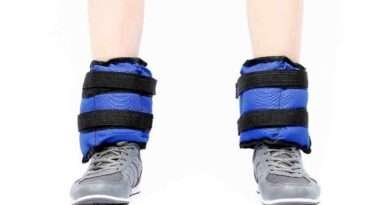Jumping Rope for Weight Loss
Jump rope is one of the easiest and most convenient exercise equipment for people who like to stay fit. It has many benefits. Many people use jumping rope for weight loss. You can burn fat quickly and improve your cardiovascular health and fitness with the versatile skipping rope exercise.
If you believe, jumping rope is only good for losing weight then you need to think again. Other than weight loss this rope has many health benefits including both mind and body. By adding jump rope workouts to your regular fitness routine, you can reach your weight loss goals and feel better all around.
Jumping rope benefits are beyond just burning calories when it comes to losing weight. If you combine rope skipping exercise with a healthy diet and other good habits, you can lose weight faster and improve your overall health and fitness. Let’s talk more about the uses and benefits of jumping rope.
Benefits of Jumping Rope for Weight Loss
Jump Rope Burn Calories
High Speed Jump Rope exercise is a quick way to burn a lot of calories. A study found that jumping rope for 10 minutes can burn the same number of calories as running for 30 minutes. This makes it a good way to make a calorie balance, which is very important for losing weight.
Full Body Workout
Jumping rope works out more than one group of muscles at the same time, unlike some types of exercise that focus on the lower body. It gives your whole body a workout by targeting your legs, core, arms, and shoulders. When you workout with this skipping rope, you not only burn more calories, but your muscles also look better.
Jumping Rope Improves Your Heart Health
You can do more than just strengthen your bones and muscles by jumping rope. Additionally, it makes your heart and lungs stronger. Multi-muscle exercises quickly get your heart rate up. In addition, jumping rope might be better for you than other cardio exercises.
How To Start Jumping Rope for Weight Loss
How to Pick the Right Skipping Rope
Choose a speed rope that is light and has comfortable handles. You should be able to reach your armpits through the middle of the rope when you stand on it.
The right way to do things
Keep good form by keeping your knees slightly bent, arms close to your sides, and wrists loose. When you jump, bend your knees a little and land softly on the balls of your feet. Turn the skipping rope with your wrists.
Starting Slowly and Moving Forward
Start with short workouts that last 5 to 10 minutes, and as your fitness improves, slowly add more time to each practice. Before moving on to more difficult moves like double unders or crossovers, make sure you can do simple jumps well.
Effective Jump Rope Workouts for Weight Loss
Interval Training
Intervals involve alternating between periods of high-intensity jumping and rest or low-intensity activity. For example, jump rope as fast as you can for 30 seconds, followed by 30 seconds of rest or light jogging. Repeat several times.
Tabata Workouts
Tabata training consists of 20 seconds of maximum effort followed by 10 seconds of rest, repeated for 4 minutes (8 rounds total). During the work intervals, perform exercises such as double unders, high knees, or alternating foot jumps.
Incorporating Jump Rope into Circuit Training
To create a challenging circuit workout, combine jump rope exercise with bodyweight exercises like squats, push-ups, or lunges. Perform each exercise for a set amount of time or repetitions before moving on to the next.
Tips for Success
Stay Consistent
Consistency is key when it comes to seeing results with jump rope exercises. Aim to jump rope at least 3-5 times per-week to maintain momentum and progress towards your weight loss goals.
Mix Up Your Jumping Rope Workouts
You can try different ways to jump rope or find new places to work out outside to keep your workouts interesting. Skipping rope is a great way to mix up your exercise routine. Take it with you when you go hiking, camping, or doing anything else outside.
Listen to Your Body
Pay attention to how your body feels during and after workouts. If you experience pain or discomfort, take a break and adjust your technique or intensity as needed. Exercise only when you are physically fit.
Common Jump Rope Mistakes to avoid
Using the Wrong Rope Length
If you use a rope that is too long or too short, it can slow you down and make you more likely to get hurt. Make sure the skipping rope fits your height, and if it doesn’t, adjust it.
Poor Form
Incorrect method not only makes your workout less effective, but it also makes you more likely to get hurt. During your jump rope sessions, make sure you maintain the right posture, pace, and technique.
Overtraining
While consistency is important, overtraining can lead to burnout, injury, or plateauing. Give your body time to rest and recover between workouts, and vary the intensity and duration of your sessions.
Nutrition Tips to Complement Jumping Rope
Balanced Diet
Fuel your body with a balanced diet rich in lean proteins, complex carbohydrates, healthy fats, and plenty of fruits and vegetables. This will provide the energy and nutrients needed to support your workouts and promote weight loss.
Adequate Hydration
Stay hydrated before, during, and after your jump rope workouts to prevent dehydration and optimize performance. Try to drink at least 8-10 glasses of water per day, or more if you’re exercising intensely or in hot weather.
Timing Meals Around Workouts
Eat a small meal or snack containing carbohydrates and protein 1-2 hours before jumping rope to fuel your workout and prevent fatigue. After exercising, refuel with a balanced post-workout meal or snack to aid in recovery and muscle repair.
Tracking Progress
Setting Goals
Set specific, measurable, and realistic goals for your jump rope workouts, such as increasing the duration or intensity of your sessions, or reaching a certain number of jumps per minute.
Keeping a Workout Journal
Track your progress over time by keeping a workout journal or using a fitness app to record your jump rope workouts, including the duration, intensity, and any notes about how you felt during the session.
Staying Motivated
Find a Workout Buddy
Working out with a friend or family member can increase accountability, motivation, and enjoyment. Find someone who shares your fitness goals and schedule regular jump rope sessions together.
Reward Yourself
Celebrate your achievements and milestones along the way with non-food rewards, such as a new workout outfit, fitness tracker, or a day off from exercise.
For weight loss motivation, you can check out this article.
Incorporating Jump Rope into Your Lifestyle
Making Time for Jump Rope Workout
Schedule your workouts at a time that works best for your schedule and lifestyle, whether it’s first thing in the morning, during your lunch break, or in the evening before dinner.
Travel-Friendly Exercise
One of the great things about jumping rope is that you can do it almost anywhere, making it an ideal exercise for travel or when you’re short on time or space.
Jump Rope Safety Tips
Check with Your Doctor
If you have any pre-existing health conditions or concerns, consult with your doctor before starting a new rope skipping exercise.
Warm-Up before jump rope exercise
Always start your jump rope exercise with a thorough warm-up to prepare your muscles and joints for exercise, and finish with a cool-down to help your body recover and reduce the risk of injury.
Start Slowly
If you’re new to jumping rope or haven’t exercised in a while, start slowly and gradually increase the jump rope exercise intensity and workout duration to avoid overexertion.
Best Jumping Rope for Weight Loss – Our Picks



Also Read: 5 Weighted Jump Rope Benefits
FAQ’s
Is jumping rope good for weight loss?
Yes, jumping rope is an excellent exercise for weight loss. It’s a high-intensity cardiovascular workout that can help you burn calories and shed excess fat when combined with a balanced diet.
jumping rope vs running?
The choice between jumping rope and running depends on factors such as personal preference, fitness goals, and physical condition. If you’re looking for a high-intensity, low-impact workout that can be done anywhere, jumping rope may be the ideal choice. On the other hand, if you enjoy the meditative rhythm of running and prefer outdoor workouts, running may better suit your lifestyle. Ultimately, adding both activities in your fitness routine can provide a well-rounded approach to cardiovascular health and overall fitness.
How long should I jump rope for weight loss?
The duration of your jump rope sessions can vary depending on your fitness level and goals. Beginners may start with 5-10 minutes per day and gradually increase to 20-30 minutes or more as they become more advanced.
Can jump rope burn fat?
Yes, jump rope can help burn fat by increasing your heart rate and calorie expenditure. It’s a highly effective cardiovascular exercise that can contribute to creating a calorie deficit, which is essential for fat loss.
How long should a jump rope be?
The length of your jump rope depends on your height and jumping style. A general rule of thumb is to stand on the middle of the rope with one foot and pull the handles up towards your chest—if they reach your armpits, the rope is the right length for you.
Is jump rope better than running?
Both jumping rope and running are effective forms of cardiovascular exercise, but they offer different jump rope benefits. Jumping rope is a high-impact workout that engages multiple muscle groups, making it more efficient for burning calories in a shorter amount of time compared to running.
What jump rope size do I need?
The size of your jump rope depends on your height and jumping style. Adjustable jump ropes are recommended as they allow you to customize the length to suit your needs. Generally, the skipping rope should reach your armpits when standing in the middle of it. A rope that is too long or too short can slow you down and make you more likely to hurt yourself. Make sure the skipping rope is the right length for you. If it’s not, you can adjust or change it.
Can jump rope make you taller?
Jumping rope exercise does not directly impact your height. However, it can improve posture, strengthen muscles, and enhance overall physical fitness, which may contribute to a taller appearance.
Is jump rope bad for knees?
Jumping rope is a high-impact exercise that can put stress on the knees, especially if done incorrectly or with poor form. However, with proper jump rope tricks and a suitable surface (jumping rope mat), jumping rope can be a safe and effective workout for most people.
How Many Jump Rope Should I Do?
You should jump according to your fitness level and goals. Once you become more proficient and fit, gradually increase your jumps per session. Over time, challenge yourself to do more by remaining consistent.
Conclusion
Clearly, jumping rope is very effective for weight loss. You can burn fat efficiently and improve cardiovascular health and fitness with this versatile jump rope tool. You can use jumping rope for weight loss and enjoy achieving your fitness goals. Let’s get started on your journey to a healthier, fitter you! Grab your jump rope and get started jumping!



